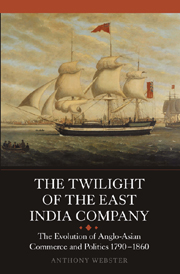 The Twilight of the East India Company
The Twilight of the East India Company Book contents
- Frontmatter
- Contents
- Preface
- 1 Introduction: The end of the East India Company, the historians and the evolution of Anglo-Indian commerce and politics
- 2 The origins of the East India Company and the rise of non-Company commercial interests in Britain, India and Asia, 1600–1793
- 3 War, politics and India: The battle for the East India Company trade monopoly, 1793–1813
- 4 Accommodating free trade: India, the East India Company and the commercial revolution of 1814–1830
- 5 Crisis and trade liberalisation 1830–1834: Financial chaos and the end of the East India Company's commercial role and privileges
- 6 Re-ordering Anglo-Asian commerce and politics: 1833–1847
- 7 Crisis, the resurgence of London and the end of the East India Company: 1847–1860
- 8 Conclusion: The decline of the East India Company and the evolution of British commercial and political interests in Asia, 1793–1860
- Notes
- Bibliography
- Index
2 - The origins of the East India Company and the rise of non-Company commercial interests in Britain, India and Asia, 1600–1793
Published online by Cambridge University Press: 12 September 2012
- Frontmatter
- Contents
- Preface
- 1 Introduction: The end of the East India Company, the historians and the evolution of Anglo-Indian commerce and politics
- 2 The origins of the East India Company and the rise of non-Company commercial interests in Britain, India and Asia, 1600–1793
- 3 War, politics and India: The battle for the East India Company trade monopoly, 1793–1813
- 4 Accommodating free trade: India, the East India Company and the commercial revolution of 1814–1830
- 5 Crisis and trade liberalisation 1830–1834: Financial chaos and the end of the East India Company's commercial role and privileges
- 6 Re-ordering Anglo-Asian commerce and politics: 1833–1847
- 7 Crisis, the resurgence of London and the end of the East India Company: 1847–1860
- 8 Conclusion: The decline of the East India Company and the evolution of British commercial and political interests in Asia, 1793–1860
- Notes
- Bibliography
- Index
Summary
THE IDEA of an East India Company with exclusive trading rights between England and the east really emerged in the last years of the sixteenth century, at a time when England faced formidable opposition from powers like Spain and Holland, who were leaders in developing commerce with both Asia and the Americas. The defeat of the Spanish Armada in 1588 was still recent in the memory and, in spite of historians' depiction of her reign as a ‘Golden Age’, in truth Queen Elizabeth I and her Court remained deeply concerned by England's vulnerability to threats from the continent. Across Europe, the ideas on political economy which came to be known as mercantilism were ascendant, and were promoted in England by such eminent scholars as Richard Hakluyt. In essence, this school of thought postulated that the wealth of the world was finite and incapable of much expansion by human endeavour, and that nations which wished to strengthen themselves against rivals needed to amass for themselves a greater share of those scarce resources. In essence this meant the acquisition of colonies in the recently discovered ‘New World’ and the monopolisation of trade in commodities such as gold, silver, spices and other precious goods.
The England of Queen Elizabeth I was a beleaguered Protestant state, confronted by powerful Catholic enemies, notably Spain and Portugal, which already enjoyed a substantial lead in the quest for mercantilist and imperial dominance. In the wings, the Dutch were also a rising world power to be reckoned with, and English efforts to challenge rivals through state-backed piracy, or the pursuit of alternative land or sea routes to the east, had met with little success.
- Type
- Chapter
- Information
- The Twilight of the East India CompanyThe Evolution of Anglo-Asian Commerce and Politics, 1790–1860, pp. 18 - 38Publisher: Boydell & BrewerPrint publication year: 2009


